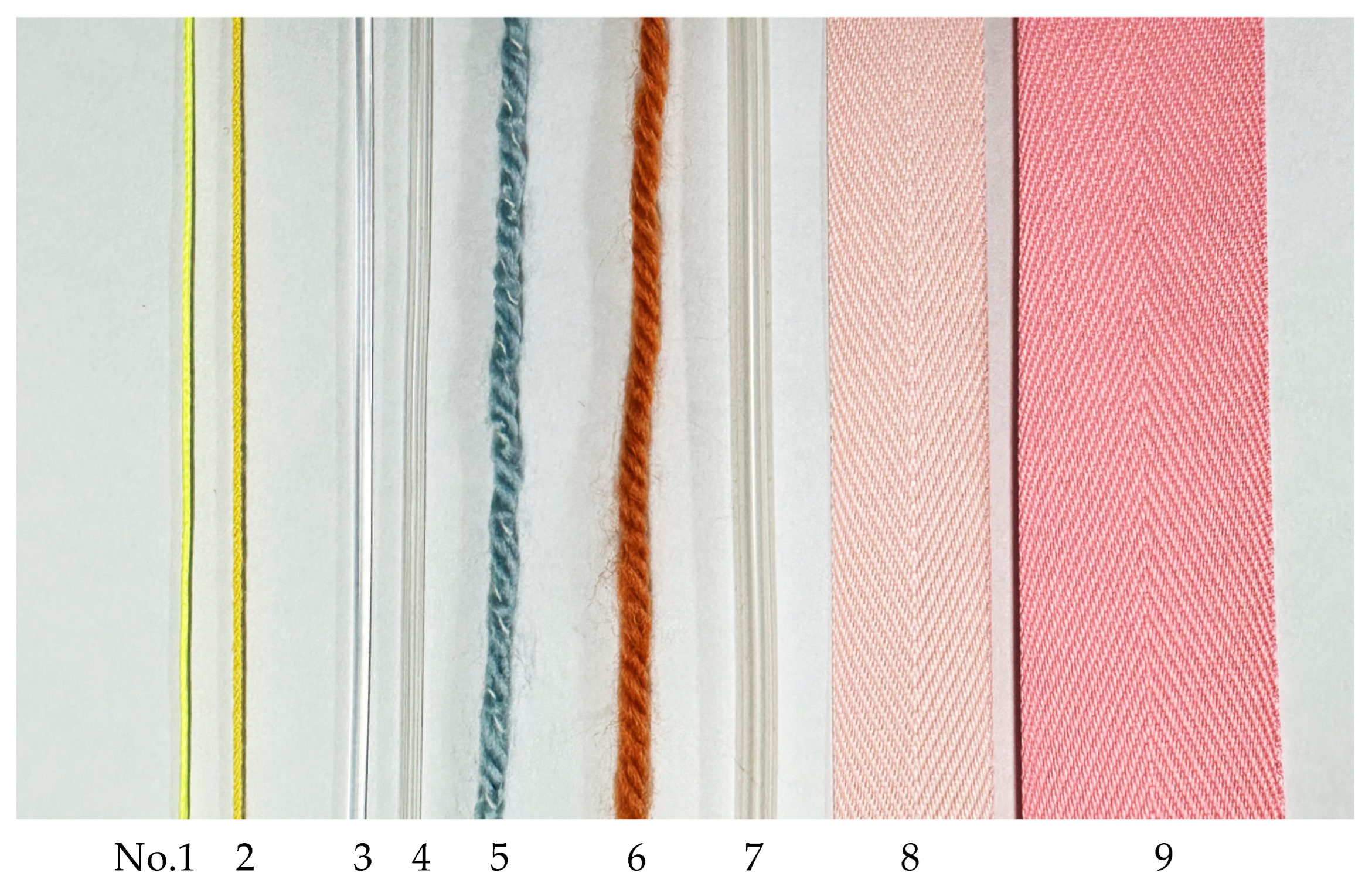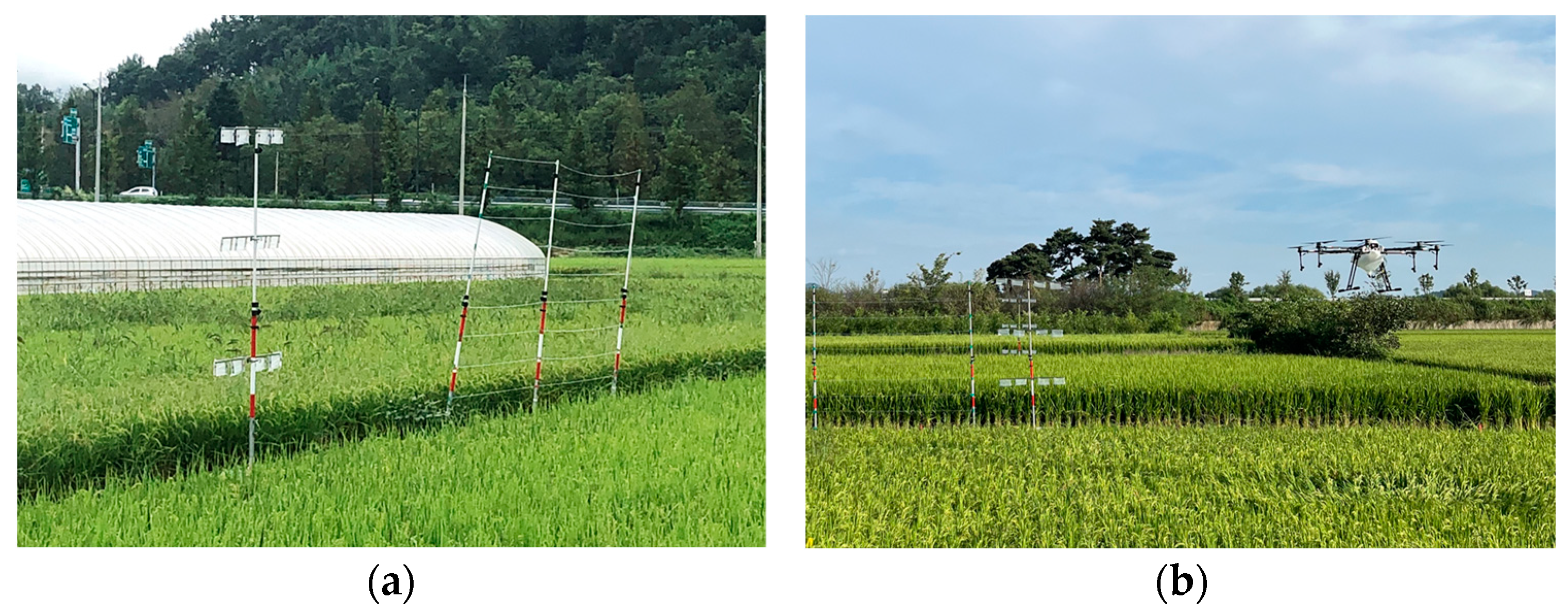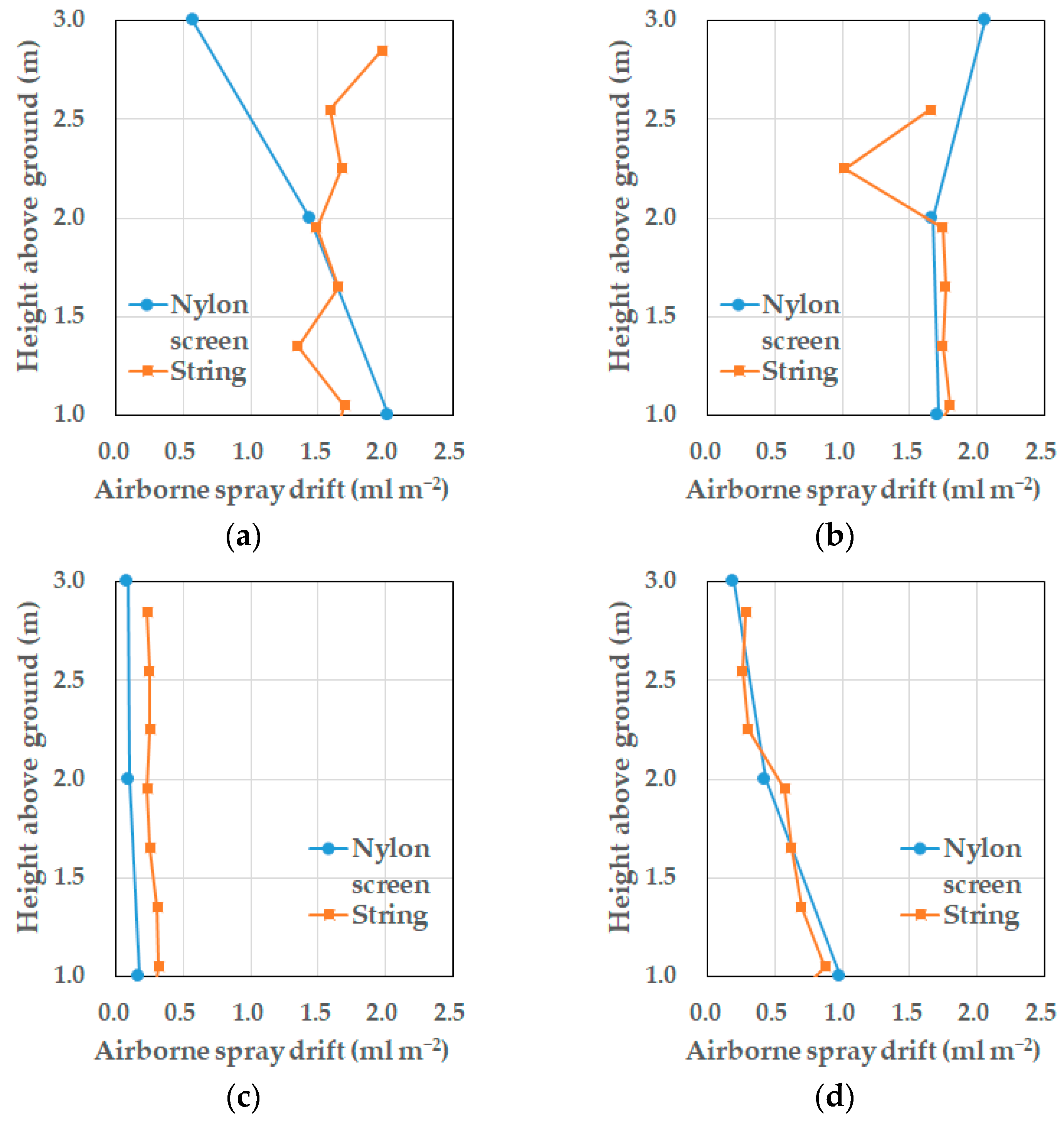3.1. Airborne Spray Droplet Size
The diameter distribution of the airborne droplets traversing the collecting section, as gauged by the PDIA, is detailed in
Table 3. As the wind speed increased, the median size of the airborne droplets increased from 86.4 μm to 145.1 μm. This suggests that heightened wind speeds exert a stronger momentum, causing airborne droplets to drift more readily. The size of these airborne droplets was recorded as being between 56–84 μm smaller than the size outlined by Park et al. [
13], attributable to the limitations of the water-sensitive paper in detecting diminutive droplets. From a methodological standpoint, the non-destructive assessment rendered by the PDIA is likely more precise. The droplets in the air were found to be smaller than those emitted from the nozzle (Dv10: 88 μm, Dv50: 166 μm, Dv90: 296 μm as observed by Park et al. [
13]). Based on our data, the largest drift droplet size is estimated to lie between 130 and 200 μm, contingent on the prevailing wind speeds.
3.2. Recovery of String Collectors
The average recovery rate of the string collectors was approximately 82% when analysed immediately following pesticide capture. This percentage reduced to around 71% when assessed 3 h after the capture and further decreased to approximately 66% upon a 10 h interval post-capture, as depicted in
Table 4. As the interval after the pesticide capture extended, a decline in the recovery rate was evident, albeit the rate of this decline progressively diminished. Hence, it is advisable to rinse and store the string collectors promptly after drift experiments in the field, where feasible.
Among the various collectors, string #5 exhibited the top recovery rate at 93.31%, with string #6 trailing at 87.45%. Both, identified as yarn strings, registered high recovery rates when rinsed immediately post-experiment. However, upon a delay of 3 or 10 h post-experiment, their recovery rates markedly decreased to figures in the vicinity of 65–69%, rendering them on par with, or slightly below, other collectors. In separate research endeavours, pipe brushes employed to gauge airborne spray drift were reported to have recovery rates oscillating between 72.5% and 78.5% [
36], whilst the monofilament line recorded a recovery rate of 74% [
37]. In light of these benchmarks, the recovery rates noted for string collectors within this study are deemed to be operationally acceptable.
3.3. Collection Efficiencies of String Collectors
Table 5 illustrates the volume of spray droplets captured by the nine string collectors under varying wind speeds. With the increase in wind speed, there was an increase in the number of airborne spray droplets, leading to a corresponding increase in the number of droplets intercepted by all the strings. This translated into an enhanced collection efficiency for all nine string collectors, as shown in
Table 6 and
Figure 4. Coinciding with the increase in wind speed, the collection efficiency for all strings increased, mirroring findings consistently highlighted in prior research [
13,
24,
31]. These studies suggest that at higher wind speeds, the kinetic energy of droplets increases allowing them to adhere more effectively to the surface of the string collector.
The nine string collectors were categorised by their type, and a Kruskal–Wallis test was carried out to determine if there was a notable disparity in collection efficiency among threads, yarns, tubes, and ribbons. The resulting p-values from the Kruskal–Wallis test stood at 0.279, 0.088, 0.088, and 0.073 for wind speeds of 0.5, 1.0, 2.0, and 3.0 m s−1, respectively. At a wind speed of 0.5 m s−1, the collection performance across the various string types displayed no significant distinction. Nevertheless, with rising wind speeds, a pattern of variable collection efficiency based on the string type began to emerge, albeit with only marginal evidence (p < 0.1). This implies that the selection of string type bears significance in terms of its efficacy as an airborne spray collector.
Dunn’s test was executed for wind speeds of 1.0 m s
−1 and beyond, where there was statistical significance as per string type, to pinpoint which string types exhibited variations. The results from Dunn’s test are detailed in
Table 7. The most prominent variations in string types were evident between yarn and tube; the distinction presented weak evidence at a wind speed of 2.0 m s
−1 but became statistically significant when the wind speed increased to 3.0 m s
−1. Yarns possess fibres on their surface, whereas tubes are of a sleek contour. In addition, yarns are crafted from acrylic-based materials, while tubes are made of silicone. The marked contrasts in both morphology and composition between yarns and tubes appear to underlie the disparities in their collection efficiency. In a similar vein, when juxtaposed with ribbons, yarns demonstrated distinctions, likely attributed to the ribbons’ distinctive form. Conversely, threads did not manifest any discernible variations when set against other varieties (ribbon, tube, yarn).
As highlighted in the statistical analysis, yarn strings exhibited unique collection performance when contrasted with other string types. As illustrated in
Figure 4, the yarn strings (#5 and #6) demonstrated a fairly consistent collection efficiency across varying wind speeds. In contrast, the other strings showcased significant fluctuations in their collection efficiency as wind speed altered. The rationale behind the yarn strings’ superior collection efficiency, even at a modest wind speed of 0.5 m s
−1, can be attributed to the delicate fibres on their surface, which adeptly ensnare even minuscule droplets [
31].
3.4. Selection of Acceptable String Collector
The primary criterion for a passive sampler is its ability to efficiently collect droplets ranging in diameter from 10 to 100 μm at subdued wind speeds of 1 m s
−1 or below [
32]. In line with these stipulations (criterion a), yarn strings #5 and #6, along with tube #7, appear to be the most fitting. Additionally, considering the findings from the recovery test, yarn strings #5 and #6, as well as thread string #3, seem to meet criterion b. In terms of cost and practicality (criterion c), yarn strings #2, #5, #6, and thread string #1 are deemed suitable for field deployment. Therefore, yarn strings #5 and #6, which fulfil all three criteria, are identified as the optimal string collectors. Between the two, string #5, displaying marginally superior collection efficiency and recovery rate, was chosen as the most apt for field testing.
3.5. Field Evaluation
The field test was conducted using String #5, comparing its measurements of airborne spray drift to those from nylon screens, as illustrated in
Figure 5. The vertical distribution of drift measured by both the nylon screens and the string collector exhibited similar patterns. Notably, Test 4 showed nearly identical trends. In Test 1, however, as the height increased, the drift captured by the nylon screens diminished, while the string collector retained a more consistent value.
Although the precise heights of the two collectors do not match perfectly, drift values from the nylon screens at 1, 2, and 3 m can be contrasted with those from strings at 1.05, 1.95, and 2.85 m. Assuming the nylon screen’s data is accurate, the string collector’s results at these heights yielded a root-mean-square error (RMSE) of 0.45 mL m−2. By excluding data at the 3 m height from Test 1—where the most significant discrepancy was noted—the RMSE drops to a more acceptable 0.15 mL m−2, especially considering the overall drift range.
Although the basic cross-sectional areas of the two samplers might seem comparable, their total drift capture areas differ. The nylon screens, comprised of 12 screens, cover a height of 3 m and a width of 1.2 m. In contrast, the string collector spans a larger region, with ten strings covering a height of 2.85 m and a width of 5 m. Additionally, while nylon screens sample at three distinct heights, the string collector covers ten. This greater granularity offers more robust validation through cross-referencing values across different heights. For example, in Test 2, the drift recorded at 2.25 m was notably less than at adjacent heights of 1.95 m and 2.55 m. Such a variation could be plausible, but it does pose questions about the measurement’s accuracy. While it is feasible to deploy additional nylon screens over a broader area to match the string collector, this method demands more effort and resources. In summary, the string collector provides a more efficient and equally reliable means of measuring airborne spray drift than the nylon screens.











